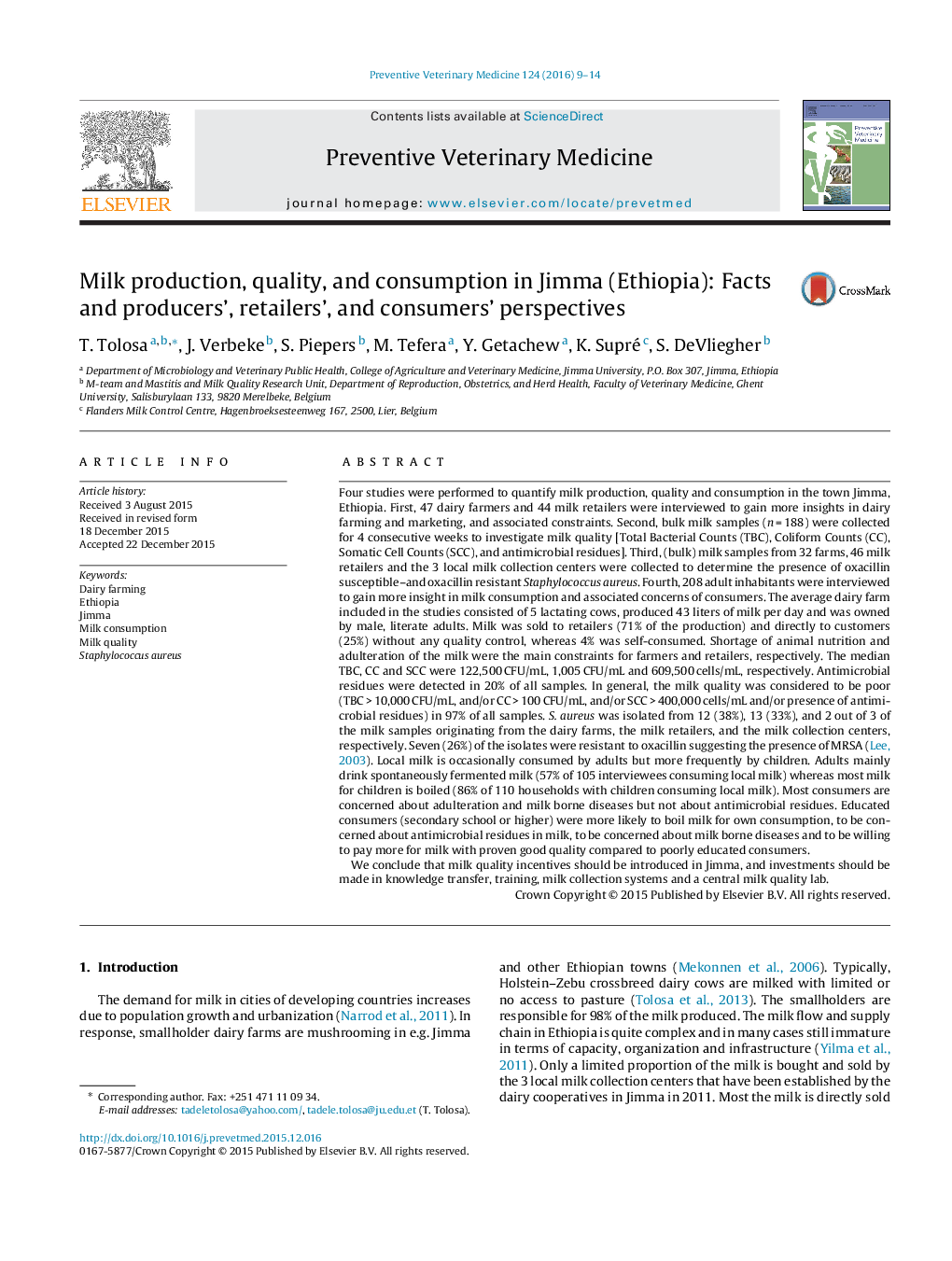| کد مقاله | کد نشریه | سال انتشار | مقاله انگلیسی | نسخه تمام متن |
|---|---|---|---|---|
| 5792974 | 1554164 | 2016 | 6 صفحه PDF | دانلود رایگان |
- Dairy farmers and milk retailers were interviewed to gain more insights in dairy farming and marketing, and associated constraints.
- Bulk milk samples were collected to picture quality.
- Presence of oxacillin susceptible-and oxacillin resistant Staphylococcus aureus were determined from (bulk) milk collection centers.
- Milk consumption and associated concerns of consumers were interviewed (of adult inhabitants) to gain more insight.
Four studies were performed to quantify milk production, quality and consumption in the town Jimma, Ethiopia. First, 47 dairy farmers and 44 milk retailers were interviewed to gain more insights in dairy farming and marketing, and associated constraints. Second, bulk milk samples (n = 188) were collected for 4 consecutive weeks to investigate milk quality [Total Bacterial Counts (TBC), Coliform Counts (CC), Somatic Cell Counts (SCC), and antimicrobial residues]. Third, (bulk) milk samples from 32 farms, 46 milk retailers and the 3 local milk collection centers were collected to determine the presence of oxacillin susceptible-and oxacillin resistant Staphylococcus aureus. Fourth, 208 adult inhabitants were interviewed to gain more insight in milk consumption and associated concerns of consumers. The average dairy farm included in the studies consisted of 5 lactating cows, produced 43 liters of milk per day and was owned by male, literate adults. Milk was sold to retailers (71% of the production) and directly to customers (25%) without any quality control, whereas 4% was self-consumed. Shortage of animal nutrition and adulteration of the milk were the main constraints for farmers and retailers, respectively. The median TBC, CC and SCC were 122,500 CFU/mL, 1,005 CFU/mL and 609,500 cells/mL, respectively. Antimicrobial residues were detected in 20% of all samples. In general, the milk quality was considered to be poor (TBC > 10,000 CFU/mL, and/or CC > 100 CFU/mL, and/or SCC > 400,000 cells/mL and/or presence of antimicrobial residues) in 97% of all samples. S. aureus was isolated from 12 (38%), 13 (33%), and 2 out of 3 of the milk samples originating from the dairy farms, the milk retailers, and the milk collection centers, respectively. Seven (26%) of the isolates were resistant to oxacillin suggesting the presence of MRSA (Lee, 2003). Local milk is occasionally consumed by adults but more frequently by children. Adults mainly drink spontaneously fermented milk (57% of 105 interviewees consuming local milk) whereas most milk for children is boiled (86% of 110 households with children consuming local milk). Most consumers are concerned about adulteration and milk borne diseases but not about antimicrobial residues. Educated consumers (secondary school or higher) were more likely to boil milk for own consumption, to be concerned about antimicrobial residues in milk, to be concerned about milk borne diseases and to be willing to pay more for milk with proven good quality compared to poorly educated consumers.We conclude that milk quality incentives should be introduced in Jimma, and investments should be made in knowledge transfer, training, milk collection systems and a central milk quality lab.
Journal: Preventive Veterinary Medicine - Volume 124, 1 February 2016, Pages 9-14
